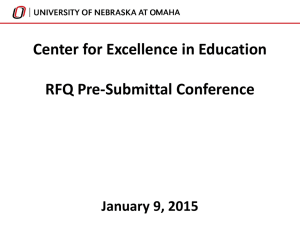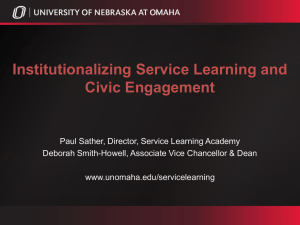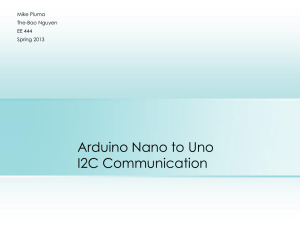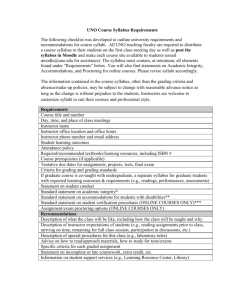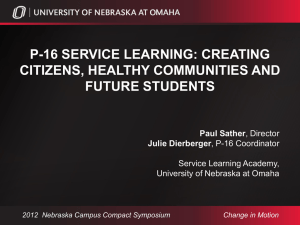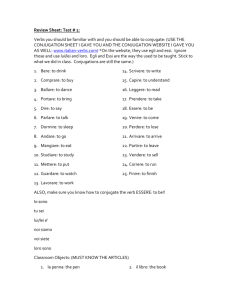Mark Reiser
advertisement
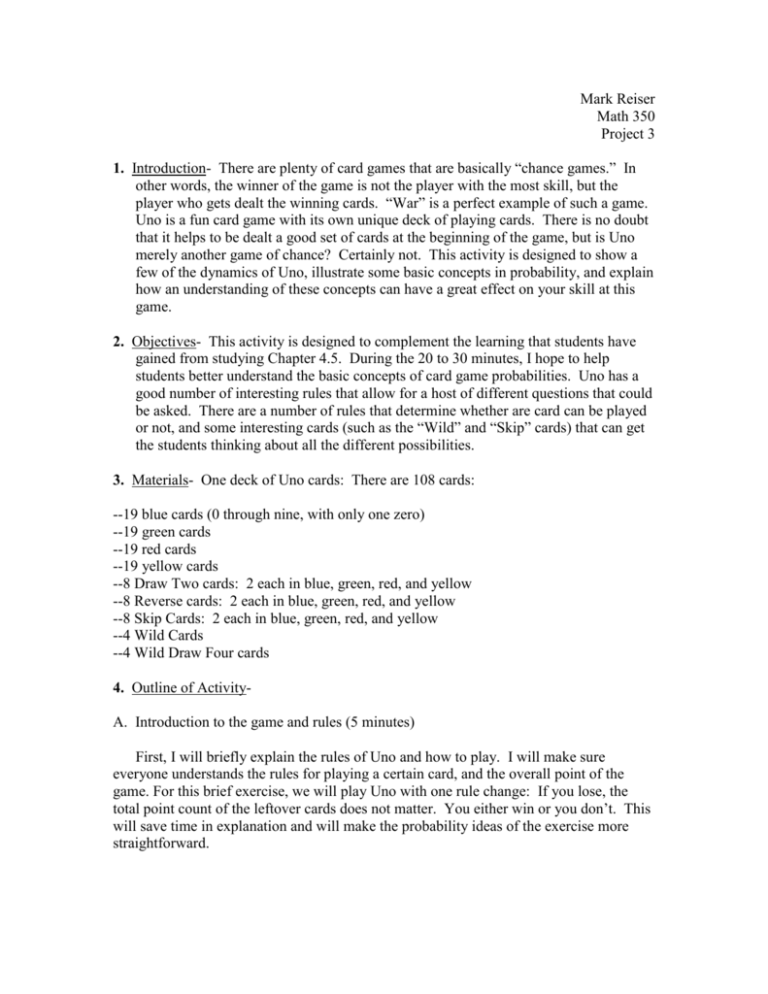
Mark Reiser Math 350 Project 3 1. Introduction- There are plenty of card games that are basically “chance games.” In other words, the winner of the game is not the player with the most skill, but the player who gets dealt the winning cards. “War” is a perfect example of such a game. Uno is a fun card game with its own unique deck of playing cards. There is no doubt that it helps to be dealt a good set of cards at the beginning of the game, but is Uno merely another game of chance? Certainly not. This activity is designed to show a few of the dynamics of Uno, illustrate some basic concepts in probability, and explain how an understanding of these concepts can have a great effect on your skill at this game. 2. Objectives- This activity is designed to complement the learning that students have gained from studying Chapter 4.5. During the 20 to 30 minutes, I hope to help students better understand the basic concepts of card game probabilities. Uno has a good number of interesting rules that allow for a host of different questions that could be asked. There are a number of rules that determine whether are card can be played or not, and some interesting cards (such as the “Wild” and “Skip” cards) that can get the students thinking about all the different possibilities. 3. Materials- One deck of Uno cards: There are 108 cards: --19 blue cards (0 through nine, with only one zero) --19 green cards --19 red cards --19 yellow cards --8 Draw Two cards: 2 each in blue, green, red, and yellow --8 Reverse cards: 2 each in blue, green, red, and yellow --8 Skip Cards: 2 each in blue, green, red, and yellow --4 Wild Cards --4 Wild Draw Four cards 4. Outline of ActivityA. Introduction to the game and rules (5 minutes) First, I will briefly explain the rules of Uno and how to play. I will make sure everyone understands the rules for playing a certain card, and the overall point of the game. For this brief exercise, we will play Uno with one rule change: If you lose, the total point count of the leftover cards does not matter. You either win or you don’t. This will save time in explanation and will make the probability ideas of the exercise more straightforward. B. Completion of the questions on the worksheet. (10 minutes) The assessment tool that I have chosen is a worksheet. I have a series of questions that I have asked the students to complete in class to get them thinking about probabilities and their role in the game of Uno. The other questions I have asked that they complete outside of class, after they have played an actual game and have had some time to think about how they played the game. C. Play a game of Uno!!! (5-10 minutes) I think the students will enjoy when we actually play a game of Uno, and see how the probabilities that they just calculated might influence how they play the game. I also want them to get a “feel” of how the game is played before they answer the last few questions, particularly the last one. I think they will better understand how the probabilities come into play if they actually get to try it! D. Discussion of strategies used (5 minutes) We will conclude with a short discussion, as I will ask each student what they were thinking as the game went on, and any strategies they may have tried to use in decided which card(s) to play. At this time, I’d ask them if they can make any connections to probabilities. I hope to make them see that they were using probability analysis even though they might not have been aware of doing so. 5. Grading and comments- The grading for what the students learned will be based on how well they finished the worksheet. I will also take a look at what kind of participation they had in the game and discussion, and whether or not they seemed to take interest and tried to get something out of it. I think that this is a good (and fun) activity for the students to get a better feel for some of the basic principles of probabilities. It will allow them to see how probabilities and mathematics can be applied in the real world (or in games!). I think one of the biggest virtues of it, however, lies in that very last question that I ask the students on the hand out. This is the question about whether Uno is merely a game of knowing probabilities or if there are some “mind tricks” that you can use on your opponent. I think this will get them thinking critically about how probabilities can be useful, but that sometimes other things are at work… It will make them think about mathematics and beyond. Most importantly, I think this activity will make them explore other games that they play, looking for these same probability principles at work. They will start looking at the underlying mathematics behind all sorts of games. That gets them thinking outside the classroom, which is the greatest gift a teacher can give to student. For final grading see the final pages, which follow the student worksheet. Student Worksheet There are plenty of card games that are basically “chance games.” In other words, the winner of the game is not the player with the most skill, but the player who gets dealt the winning cards. “War” is a perfect example of such a game. Uno is a fun card game with its own unique deck of playing cards. There is no doubt that it helps to be dealt a good set of cards at the beginning of the game, but is Uno merely another game of chance? Certainly not. This activity is designed to show a few of the dynamics of Uno, illustrate some basic concepts in probability, and explain how an understanding of these concepts can have a great effect on your skill at this game. Here is a standard deck of Uno: (108 cards) --19 blue cards (0 through nine, with two of each number but only one zero) --19 green cards --19 red cards --19 yellow cards --8 Draw Two cards: 2 each in blue, green, red, and yellow --8 Reverse cards: 2 each in blue, green, red, and yellow --8 Skip Cards: 2 each in blue, green, red, and yellow --4 Wild Cards --4 Wild Draw Four cards Based on this knowledge, answer the following questions: 1. The cards have been properly shuffled, the cards have just been dealt, and you are playing a game with a total of three people. Obviously, you do NOT know the identity of the other two player’s seven cards. Upon the first card being flipped over at the start of the game, what is the probability that the first person to go will be able to play one of his/her seven dealt cards if the card is a: a. b. c. d. e. red 2 ? blue 6 ? yellow Reverse? green 0 ? a Wild card --Does the fact that the other two players have seven cards in hand effect the probability for your answers above? Why or why not? In other words, would the answers to this question change if we had 4 players in our game? --What is the probability that the first person will NOT be able to play one of his/her seven cards for each of the five cases above? There is a simple rule you may want to use that allows you to use very simple subtraction to obtain these answers, as long as you got the original probabilities correct. What is this rule called? --What is the probability that ANY of the three players has a playable card for each of these five scenarios? What rule are you using to find this answer? Is this an “AND” or an “OR” problem? 2. Looking at these probabilities in a different way, we can look at some strategies as to how we might improve our odds at getting rid of cards in Uno. For example, if we look at the answers of question 1, these probabilities can also tell us how easy it is to “get rid” of a card. For example, if you said that there was a high probability that one of the players would have a card that could be played on a blue 6, then you might conclude that this card is easier to get rid of than most cards. Since getting rid of your cards is the point of the game, and based on your answers in question 1, which of these cards might you want to get rid of first? a. b. c. d. e. red 2 ? blue 6 ? yellow Reverse? green 0 ? a Wild card (if one card is no more favorable to get rid of than another, this is fine.) The rest of the handout is to be completed outside of class: 3. Let’s say you are an unethical card player. Before the game started, the other two players got a snack, and you looked at their cards. --Player two has a blue 5 and a blue 7, a yellow 1, a Wild card, a green Draw Two, a red 0 and a red 9. Player three has a Wild Draw 4, a yellow Reverse, a blue Reverse, a red 6 and a red 4, and a two green 3’s. If you go first after the card is flipped, what is the probability that you will be able to play each of the five cards listed before: a. b. c. d. e. red 2 ? blue 6 ? yellow Reverse? green 0 ? a Wild card --Are these answers different from those the time you answered this question in class? If so, is it simply because these two players have 14 of the deck’s 108 cards in their hands, or is it something else? (Be specific) 4. If you were thinking critically during the game we played, what did you do as the game went along? Were you paying attention to the cards that were already played? Do the probabilities of being able to play a certain card change as the game goes on? --Based on this knowledge, what strategies might you adopt for the rest of the game if you notice the following: a. a great number of “4’s” have been played? b. a great number of green cards have been played? c. You have three Wild cards in hand? d. You notice that the person following you has played three reds in a row, and they are about to lay down their last card? e. The person following you has just laid down a Wild card and called, “Uno.” They have one card left, and they have called the color “yellow.” Do you unquestionably try to change the color to something other than yellow? Is being good at statistics the ONLY knowledge you need to become a good Uno player, or can it sometimes involve simply being clever and fooling people?
